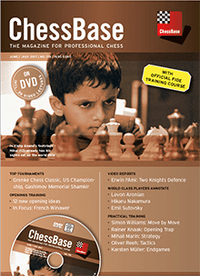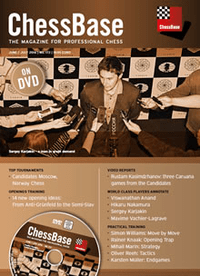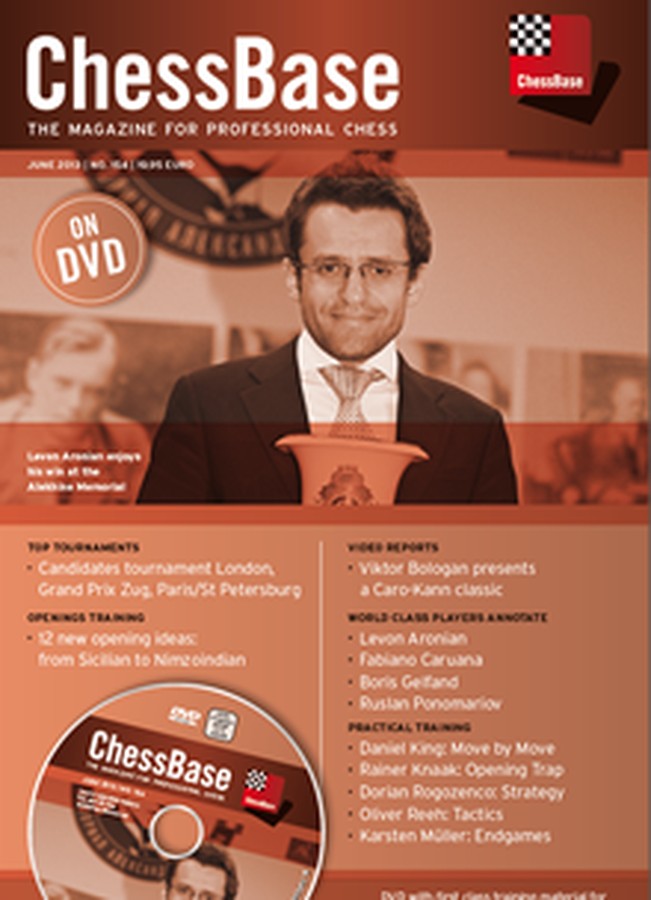| Nivå | B-D |
| Utgivelsesdato | Juni 2013 |
| Forfatter | |
| Pris | 230 NOK |
ChessBase Magazine 154 (June/July 2013)
The Magazine for Professional ChessAronian troner med seierstrofeet fra Alekhine Memorial på forsiden, men aller mest finkjemmes kandidatturneringen i London i denne velfylte utgaven av DVD-magasinet. Kramnik, Aronian, Caruana, Gelfand og Ponomariov er blant forfatterne.
Som vanlig er det også stort fokus på de 12 åpningsartiklene og på mye fint treningsstoff å sette rett inn i PCen. I det hele tatt masse glimrende stoff for både vanlige klubbspillere og ambisiøse mesterspillere...
INNHOLDET DENNE GANG:
In his introductory video Grandmaster Karsten Müller takes a first glance over the contents of the DVD. For example, he casts some light on the decisive moments of Carlsen’s victory as White over Gelfand in the candidates tournament in London. Of the 12 openings articles on the DVD the one which particularly attracted Müller was the contribution by Zoltan Almasi on the Parma Variation in the Nimzo-Indian Defence.
Tournament highlights
Dorian Rogozenco devotes the first of his two highlights videos entirely to the candidates tournament. For example, he presents Aronian’s fantastic endgame victory over Gelfand. A further focus of Rogozenco’s attention in this video is Kramnik’s various opening innovations in London. For the second video the Romanian GM has, e.g., picked out Topalov’s win over Nakamura (Zug) and Aronian’s brilliant victory against Svidler’s Grünfeld Defence (Paris/St Petersburg).
Pure Training
Here we have collected all games with training questions. By clicking at the icon you get by chance one position with a training question.
21.04.-01.05.2013
Levon Aronian Victor thanks to fewer drawn games Aljechin-Memorial Paris/St Petersburg
It will hardly have been a real consolation for Levon Aronian, but at least some sort of satisfaction. At the WCh Candidates Tournament (see below) he still had good chances of victory in the tournament after the first flight of games, but then decisively fell behind. However, in the Alekhine Memorial he managed to win the tournament ahead of Boris Gelfand who had the same number of points, and he achieved this not only ahead of Kramnik but also of World Champion Anand. As in the candidates tournaments the deciding criterion in the Alekhine Memorial was also the number of games won.
Aronian - Kramnik,V Position before 17.Qe3 In achieving victory Levon Aronian also had his revenge on Vladimir Kramnik. In the candidates tournament he had faced bitter defeat in his game as White against the ex world champion (see Karsten Müller’s endgame analysis on the DVD). In St. Petersburg the Armenian decided to tackle Kramnik’s fortifications in a different way. In his analysis on the DVD Aronian explains the plan which he followed starting from the position in the diagram: with the move 17.Qe3 White clears the way for his own f-pawn. The aim is to exchange this pawn for the black e-pawn and thus to create a strong passed pawn on the d-file. And that is what happened in the game! Click on the link under the diagram and have Levon Aronian explain to you how he went about winning.
Boris Gelfand Good form, good humour Without Magnus Carlsen, against whom Boris Gelfand lost both his games in London, the latest WCh challenger would have been practically unbloodied over the last few months. The good form he had had in London was confirmed in impressive fashion in the Alekhine Memorial. Gelfand was the only player to remain undefeated and ended the tournament on the same number of points as the victor thanks to two wins against Adams and Ding Lirem.
Gelfand - Adams,M Position after 24...Kg7 On the DVD Boris Gelfand annotates his third-round win against Michael Adams who had made an excellent start. The Israeli was successful in this game with the rare Bf4-variation of the Queen’s Gambit. Gelfand created his decisive advantage in the position in the diagram by means of a little dance with his knight: 25.Nd6 Rb8 26.Ne8+ Kf8 27.fxg6 hxg6 28.Nxc7 first of all won him a pawn. And because after 28...Bf6 29.Rb3 Adams took the wrong decision in the form of 29...Be5 – the more active defence with 29...Rd8 was the right idea – Gelfand was able to find an effective post for his knight on d3 and then go on to realise his advantage one bit at a time. A brilliant game for which the veteran received the prize for the best technique!
18.04.-30.04.2013
Veselin Topalov Clear winner FIDE Grand Prix Zug
In April the FIDE cycle saw its third event take place in the Swiss town of Zug. Unlike the previous tournaments in London and Tashkent there was no neck and neck finish on this occasion. With his victory over the pursuing Caruana in penultimate round Veselin Topalov secured himself sole victory in the tournament with a round to go and on the following day even scored another win, over Karjakin this time. You will find on the DVD two games by the victor annotated by GM Krasenkow.
Caruana annotates Kamsky - Caruana In the Kamsky-Caruana game the contestants found themselves in new territory as far as the American was concerned in a Ruy Lopez after the rare 9.Be3 and 10.axb5. In his analysis Fabiano Caruana takes a detailed and microscopic look at the (in no way error-free) opening play of both sides. The decisive mistake was made by Kamsky in an already worse position (see diagram). After 33.Qe3 the black queen forced the decision with 33...Qa1 34.Kf3 Qd1+ 35.Qe2 Qh1+ 36.Ke3 Qxd5.
Ponomariov - Kamsky Position before 29.d5 Ruslan Ponomariov also managed to defeat Gata Kamsky. The Ukrainian explains in his analysis on the DVD, how he used various transpositions of moves to entice his opponent into an opening variation with which he was not too familiar (in the Nimzo-Indian Defence) and promptly took advantage of an inaccuracy on his part. In fact, in the subsequent play Ponomariov got more space and the better game. On move 29 the found the position ripe for a decisive strike: after the breakthrough 29.d5 Kamsky went wrong with 29...f5 30.exf6 Rxf6 (followed by 31.Re1), but even after 29...exd5 30.e6 the black position could no longer have been held.
15.03.-01.04.2013
Magnus Carlsen to challenge the world champion WCh Candidates Tournament London
In London in March it became clear that a candidates tournament belongs to quite a different category from all “normal” supertournaments which one can see and admire in any year with a similar cast list. For example, at the end of the tournament Magnus Carlsen lost twice with the white pieces. And even that was finally enough to win the tournament, last but not least because his keenest rival, Vladimir Kramnik, had believed that in the final round he had to play for a win at all costs. But in the long run it was this defeat which cost the ex world champion his ticket to India.
Carlsen - Gelfand Position after 23.b2-b4 On the DVD Carlsen’s second Peter-Heine Nielsen annotates the first and of course enormously important win by the new WCh challenger in the third round. The analysis is presented as a personal vote of thanks by Magnus Carlsen to his helpers and above all to Peter-Heine Nielsen. In the game Carlsen chose in the Rossolimo Variation (3.Bb5) with rapid kingside castling and the retreat of the bishop to f1 a long-term and positional plan. In the position on the left the Norwegian’s long-range vision was correct as he chose the risky looking 23.b2-b4. At this point he would already have seen the winning queen shift on move 28 from h5 to a5, a square which was even still being threatened by the rook!
Kramnik - Svidler Position after 14.Kd2-c2 For over 10 years Vladimir Kramnik had been carrying around with him an innovation in the Grünfeld Defence Exchange Variation. In London the time had come. He had White against Peter Svidler and he deviated from the then main move 14.Ke1 to move his king on to a square which it had never yet occupied in this variation. After Svidler’s solid but slightly passive reply 14...Ne5 and the exchange of knights Kramnik obtained an objectively somewhat better position and at the same time made the most of the advantage given by his home preparation. Play through the game and enjoy the great win and the comments by the previous world champion!
Openings report
Almost all the games from the candidates tournament are commented on extensively on the DVD. In addition, Romanian grandmaster Mihail Marin has brought together for you in his Openings report the latest trends and ideas. As well as Marin, grandmasters such as Krasenkow, Mikhalchishin, Postny, Stohl and Szabo have contributed analyses.
Round-up Shows with Daniel King On the DVD you will also find all the round by round analyses from the London candidates tournament, by GM Daniel King in ChessMedia format.
Georgiev-Dvirnyy, Skopje Position after 22.Qb4 In tactics, frequently the small things are what decide a game. Here, how does Black manage not to lose his a4-pawn? Solution only in the tactics column. From the opening trap to the endgame study
Training in ChessBase Magazine begins with the very first moves and takes in all the phases of a game of chess. You can also reach the 12 up-to-date openings articles with their numerous ideas and suggestions for your repertoire above via the links. This time the Opening trap by Rainer Knaak (including its Fritztrainer video) deals with a trap in the Italian Game (C56). You can also find in video format the openings contributions by Viktor Bologan (Caro-Kann Main Variation) and Andrew Martin (Queen’s Gambit Exchange Variation). Take a look at the contents in the column on opening videos. Daniel King’s long-running Move by Move column takes as its subject the Ruy Lopez game Svidler-Carlsen. This time it is presented completely in the new interactive video format. The subject tackled by Dorian Rogozenco in his strategy column is: "Open files". And in the tactics (subject: pawn power in front of the opposing king) and endgame (subject: knight magic) columns Oliver Reeh and Karsten Müller have once again brought together all that is best from recent tournament practice.
Opening articles
Rotstein: Modern Defence A42
1.d4 g6 2.c4 Bg7 3.Nc3 d6 4.e4 e5 5.Nf3 exd4 6.Nxd4 Ne7
Black tries to improve on the King’s Indian and it is not easy for White to find a good setup against it. In any case, standard moves are hardly suited to the task and 7.h4 is more promising. Arkadij Rotstein goes far beyond theory in his article.
Stohl: Sicilian B33
1.e4 c5 2.Nf3 Nc6 3.d4 cxd4 4.Nxd4 Nf6 5.Nc3 e5 6.Ndb5 d6 7.Bg5 a6 8.Na3 b5 9.Nd5 Be7 10.Bxf6 Bxf6 11.c4
After 11.c4 positional factors play a much greater role than in the usual Sveshnikov variations, which will not suit players with Black, who are intent on a sharp struggle. Igor Stohl brings them up-to-date with the latest trends in this variation.
Ftacnik: Sicilian B90
1.e4 c5 2.Nf3 d6 3.d4 cxd4 4.Nxd4 Nf6 5.Nc3 a6 6.h3 e5
The actually harmless move 6.h3 has turned out in recent years to be quite venomous. Nowadays 6...e5 is considered to be the strongest reply. In Lubomir Ftacnik’s article the numerous games from the engine room in playchess.com are also taken into account.
Schipkov: French C00
1.e4 e6 2.f4 d5 3.e5 c5 4.Nf3 Nc6 5.c3
This ancient plan is seen very rarely these days, but Hikaru Nakamura had to face it with Black and then later successfully used it himself as White. Boris Schipkov shows in his article that Black has nothing to fear if he plays accurately.
Kritz: French C07
1.e4 e6 2.d4 d5 3.Nd2 c5 4.exd5 Qxd5 5.Ngf3 cxd4 6.Bc4 Qd6 7.Qe2
With 7.Qe2 White is aiming to castle long and the Rd1 is intended to support the recovery of the d4-pawn. In practice this works quite well but nevertheless there is no great advantage to be had. Leonid Kritz shows you the best way to play it for White and for Black.
Moskalenko: French C18
1.e4 e6 2.d4 d5 3.Nc3 Bb4 4.e5 c5 5.a3 Bxc3+ 6.bxc3 Qc7 7.Qg4 f5
The line 6...Qc7 no longer has so many fans these days, probably many players find ...f5 just too disadvantageous: ...f6 is no longer possible, White gets the f4-square. But Viktor Moskalenko has his own views. As he usually does, he backs up his theses with a lot of his own games.
Karolyi: Slav Defence D10
1.d4 d5 2.c4 c6 3.Nc3 Nf6 4.cxd5 cxd5 5.Bf4 Qb6
The queen move casts a spanner into the workings of the white setup and forces White to make a decision: to protect the b2-pawn or not. In his meticulous article Tibor Karolyi favours Black, but so far there have been too few games at a high level for a soundly based evaluation.
Marin: Queen's Gambit D35
1.d4 d5 2.c4 e6 3.Nc3 Nf6 4.Nf3 Nbd7 5.cxd5 exd5 6.Bf4
Mihail Marin’s article is about 6...Nb6 or the more frequently seen 6...c6 7.e3 Nb6. The surprising knight move to b6 has its strengths and has never been refuted. Despite that it is played very rarely.
Krasenkow: Grünfeld Defence D78 1.d4 Nf6 2.c4 g6 3.g3 c6 4.Bg2 d5 5.Nf3 Bg7
The setup with c6 and d5 is considered the most reliable system against the white fianchetto variation – both in the Grünfeld and in the King’s Indian. Michal Krasenkow shows in the first part lines in which White does not exchange on d5. Black does not find it difficult to equalise.
Almasi: Nimzoindian E55
1.d4 Nf6 2.c4 e6 3.Nc3 Bb4 4.e3 c5 5.Nf3 0-0 6.0-0 dxc4 8.Bxc4 Nbd7
The variation with 8...Nbd7 is somewhat more flexible than taking on d4, In it White is left in uncertainty as to what Black’s intentions are. Zoltan Almasi is a great specialist in this variation and in his article he shares with us a lot of background knowledge.
Kuzmin: Nimzoindian E56
1.d4 Nf6 2.c4 e6 3.Nc3 Bb4 4.e3 0-0 5.Bd3 d5 6.Nf3 c5 7.0-0 Nc6 8.cxd5 exd5 9.dxc5 Bxc5 10.h3
For a long time 8.a3 was considered obligatory and after it Black had several acceptable variations at his disposition. With the relatively new setup suggested here by Alexey Kuzmin White aims for an IQP position in which it is not easy for Black to equalise.
Postny: King's Indian E81
1.d4 Nf6 2.c4 g6 3.Nc3 Bg7 4.e4 d6 5.f3 0-0 6.Be3 c5 7.Nge2 Nc6 8.d5 Ne5 9.Ng3 h5 10.Be2 h4 11.Nf1 e6
The position in the diagram was on the board in the candidates tournament in Svidler-Grischuk. A sharp struggle developed after 12.f4 Nxc4!. Evgeny Postny puts this under the microscope. But the Israeli also investigates White’s alternatives on move 12.
| Type | DVD |
| Språk | Engelsk |
Produktet er en del av serien ChessBase Magazine
Et DVD-magasin som gir god valuta for pengene og stadig forfines og utvides. Her er det stoff i alle faser av spillet, og ikke minst aktuelle åpningsartikler i hver utgave. Sammen med selve DVD-produktet kommer det alltid et trykket magasin som gir god oversikt over stoffet og noen utvalgte treningsgodbiter å bryne seg på.
Se også
-

ChessBase Magazine 178 (June/July 2017) DVD
KjøpDet indiske stortalentet Nihal, som også har besøkt Norge, har kommentert et parti i nyeste ChessBase Magazine, og har bilde på omslaget. Mye annet godt stoff også, deriblant 12 aktuelle åpningsartikler av eldre forfattere...
- Pris
- 230
- Nivå
- C-D
- Av
- Utgivelsesdato
- Juni 2017
-

ChessBase Magazine 172 (June/July 2016) DVD
KjøpKandidatturneringen i Moskva og Norway Chess i Stavanger er hovedbegivenhetene som dekkes i denne utgaven av DVD-magasinet. Like viktig er vel 14 nye åpningsartikler og godt treningsstoff i alle spillets faser!
- Pris
- 240
- Nivå
- B-D
- Utgivelsesdato
- Juni 2016

